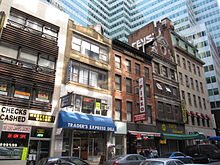Beaver Street (Manhattan)
[4] The latter originally existed as two separate tributaries of the Broad Street canal; the section west of modern-day Broad Street was called Bever Graft or Beaver Canal,[5][6]: 6 while the section to the east was called De Prince Graft or Prince Canal,[6]: 52 which ended in a ditch that the Dutch called a "sloot".
[3]: 9 [6]: 36 On September 8, 1664, the Dutch forces marched out of Fort Amsterdam with all battle honors and proceeded down Beaver Street to embark on board the Gideon bound for the Netherlands, thus transferring the colony of New Netherland to English control.
Marinus Willett and others confronted them at the intersection of Broad and Beaver Streets and confiscated a number of carts loaded with arms to prevent them being taken back to the ships.
[11] The western end of Beaver Street contains the Standard Oil Building at 26 Broadway.
[12]: 2 [15][16] The current 31-story structure, completed in 1928 as part of another expansion, replacing a Childs Restaurants location among other businesses.
Constructed between 1903 and 1904 as a speculative development, it is a New York City landmark and on the National Register of Historic Places.
[24] 1 Wall Street Court was originally known as the Beaver Building and contained the offices of the Munson Line, a steamship-line company in the Americas.


